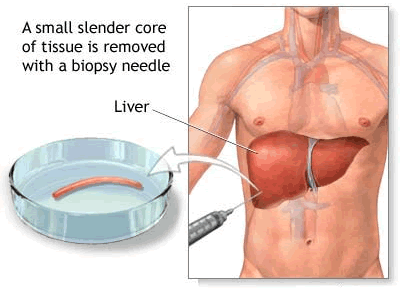Biopsy
Study Suggests Liver Disease Does Not Progress Faster in HIV/HCV
Coinfected People
 |
 |
 |
 |
 |
 |
 |
| SUMMARY:
A poster presented last week at the 45th Annual Meeting
of the European Association for the Study of the Liver
(EASL 2010) in Vienna suggests
that HIV/HCV
coinfection may not significantly accelerate liver
fibrosis progression compared with HCV
alone. This biopsy study adds to a conflicting body
of evidence about the impact of HIV on hepatitis C pathogenesis.
|
|
 |
 |
 |
 |
 |
 |
 |
By
Liz Highleyman
It
is generally assumed that HIV/HCV coinfected is associated with
more rapid liver disease progression compared with hepatitis C
virus (HCV) infection alone, but studies to date have produced
conflicting results, during both early and later stages of HCV
infection.
 Researchers
at Mt. Sinai School of Medicine in New York City first reported
in 2007 that liver biopsies from HIV positive men showed alarmingly
high rates of fibrosis progression after only a short duration
of HCV infection.
Researchers
at Mt. Sinai School of Medicine in New York City first reported
in 2007 that liver biopsies from HIV positive men showed alarmingly
high rates of fibrosis progression after only a short duration
of HCV infection.
At the recent 17th Conference on Retroviruses and Opportunistic
Infections (CROI 2010), European
investigators reported an extremely high rate of apparent
fibrosis progression over a short interval in HIV positive people
with recent HCV infection using the FibroScan method. The rate
was so high, in fact, that the investigators concluded that dramatic
short-term changes in FibroScan measurements during acute infection
likely do not reflect actual rapid fibrosis, but may be influenced
by inflammation.
FibroScan, or transient elastometry, uses ultrasound to measure
liver "stiffness," which is used to estimate fibrosis
stage. Though not as accurate as liver biopsy, it is non-invasive
and less expensive, making it more acceptable for serial assessments
over time.
Looking at longer-term chronic hepatitis C, Spanish
investigators reported reported at CROI that despite effective
antiretroviral therapy (ART), liver fibrosis progresses in a significant
proportion of HIV/HCV coinfected patients over a relatively short
period, again based on a FibroScan analysis.
Now, in the study presented this year at EASL, U.S. researchers
have found -- using the liver biopsy "gold standard"
-- that fibrosis progression appears similar in HIV positive and
HIV negative individuals with chronic HCV infection.
Richard Sterling and colleagues from Virginia Commonwealth University
conducted a prospective longitudinal cohort study to compare fibrosis
progression using paired liver biopsies in HIV/HCV coinfected
people and those with HCV alone, and to assess factors associated
with worsening liver disease.
Out of a cohort of about 300 HIV/HCV coinfected patients, the
researchers identified 56 people without cirrhosis at baseline
who underwent paired liver biopsies. The average age was 44 years,
about 80% were on ART, and the median CD4 count was high at 571
cells/mm3, but only 40% had HIV viral load < 400 copies/mL.
These coinfected participants were matched with HCV monoinfected
patients based on demographic characteristics, initial fibrosis
stage, and hepatitis C treatment status. The coinfected patients
had a shorter average interval between biopsies than the HCV monoinfected
individuals (4.7 vs 5.9 years).
Results
 |
Liver
biopsies from HIV/HCV coinfected patients showed significantly
higher piecemeal necrosis (dead liver cells) and lobular inflammation
compared with HCV monoinfected participants. |
 |
Between
the first and second biopsies, coinfected participants and
those with HCV alone experienced the following outcomes: |
| |
 |
Fibrosis
remained unchanged: 55% of coinfected vs 45% of HCV
monoinfected; |
 |
Fibrosis
progressed 1 stage: 18% vs 30%, respectively; |
 |
Fibrosis
progressed 2 stages: 18% vs 9%, respectively. |
|
 |
The fibrosis progression rate was statistically similar between
the HIV/HCV coinfected and HCV monoinfected groups (0.13 vs
0.064 units/year; P = 0.72). |
 |
Among
the coinfected participants, no associations were observed
between fibrosis progression and any of the following factors: |
| |
 |
Demographics
(age, sex, race/ethnicity); |
 |
CD4
cell count; |
 |
Antiretroviral
therapy use; |
 |
ALT
and AST liver enzyme levels; |
 |
Baseline
liver disease (inflammation, fibrosis, or steatosis); |
 |
Response
to hepatitis C therapy. |
|
Based
on these findings, the researchers concluded, "When matched
for baseline fibrosis, fibrosis progression is similar in HIV/HCV
coinfection and HCV monoinfection."
The previous reports of rapid disease progression in coinfected
patients, they suggested, "may have been biased by patient
selection in the early HAART era."
However, since there were no clinical or laboratory parameters
that predicted disease progression, the researchers recommended
that "all coinfected patients should be considered for repeat
assessment of disease severity by liver biopsy at periodic intervals
in order to identify those who progress."
Gastroenterology, Hepatology, and Nutrition, Biostatistics,
Virginia Commonwealth University, Richmond, VA.
4/20/10
Reference
R
Sterling, JA Wegelin, PG Smith, and others. A prospective evaluation
by paired biopsy of fibrosis progression in HIV-HCV coinfection
compared to HCV monoinfection. 45th Annual Meeting of the European
Association for the Study of the Liver (EASL 2010). Vienna, Austria.
April 14-18, 2010. Abstract
1082.